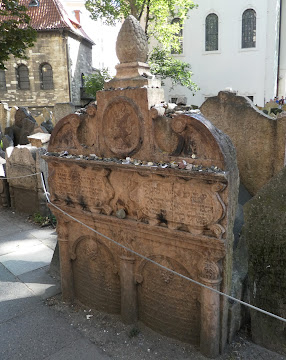In my earlier post about this summer’s Fantasy Safari, there was one mythical creature I didn’t mention, even though I followed his trail. That’s because the Golem of Prague deserves a post of his own. Yes, I discussed golems before in my post on Artificial Life, but today we’re going to look at the Golem of Prague in more detail. The first thing to acknowledge is that while stories of golems are ancient in Jewish mythology, the Prague Golem is the product of a much more recent legend, apparently first invented in the early nineteenth century. Since then, however, it has become the most famous and archetypal golem legend. It goes like this:
Rabbi Judah Loew ben Bezalel, known as the Maharal, was a leading rabbi in Prague in the sixteenth century, as well as a scholar, mystic, mathematician, astronomer, and philosopher (c. 1520-1609). This summer I visited his gravestone in the Old Jewish Cemetery in Prague. In 1592 he had an audience with Holy Roman Emperor Rudolph II, who wanted to discuss Kabbalah. With all this, it’s obvious that Rabbi Loew must have been an alchemist as well as a godly man, and that’s how he came to have the mystical powers and esoteric knowledge of how God created Adam from clay. He used this knowledge to create a golem, which he intended to be a protector of the Jewish community, which was under attack from the usual antisemitic horrors. (The legend blames Rudolph II for having planned to expel or murder the Jews of Prague, but historically he seems to have been quite tolerant, relatively speaking, and the Jewish population of Prague thrived under his reign.) At any rate, Rabbi Loew took clay from the banks of the River Vltava and made the golem, who was named Josef (nickname Yossele), and in addition to being alive, some versions say he had the power of invisibility and summoning spirits from the dead.
The punchline of the legend, however, is that eventually the golem ran out of control and went on a rampage, and Rabbi Loew had to destroy him. There are a number of different versions of how that all went down. According to some versions, Rabbi Loew always deactivated Yossele on Friday evenings so that he wouldn’t do work on the Sabbath - until one day when Loew forgot. According to another version, the golem fell in love and became violent when he was rejected. There are also a couple of versions of how the golem was destroyed: 1. He was animated by a shem placed in his mouth - the shem being one of the names of God written on a piece of paper or a clay tablet. In order to deactivate him, the shem had to be removed. 2. He was animated by writing the Hebrew word emét (“truth”) on his forehead. In order to destroy him, the initial e was erased, leaving the word mét (“dead”). Why are there so many different variations? Simply because this legend has absorbed influences from all the other golem stories in the folklore.
So, Yossele was deactivated and fell back into a heap of clay, which was then stored in the attic of Prague’s Old New Synagogue. The door was locked and everyone was forbidden to enter. I saw the exterior door to the attic, and the rung ladder to reach it, but you are still forbidden to enter. Supposedly he lies there still, King Arthur-like, ready to be brought back to life again if need arises. Unfortunately for that theory, renovations of the building in 1883 required entering the attic, and no golem was found. Perhaps it’s a reaction to that let-down that gives us the alternate
version in which the golem’s remains were removed from the attic and buried in the Žižkov graveyard. If that’s the case, then he may be gone forever, as parts of the graveyard were destroyed in 1985-92 when the crazy Žižkov Television Tower was built there during the Communist era.
While the Golem of Prague was first mentioned in the 1830s, it very quickly spawned a variety of stories, followed by novels, and then films, and so on. I confess that I’m not much interested in many of these - especially not those of the horror variety! But I do find lots to mull on in the themes that swirl around the original
mythology of golems: the power to create life and the desire to control it, puzzles of sentience and free will, golem as savior versus monster, and so on. Therefore I was pretty excited to visit a real golem’s stomping grounds and find his traces! And of course since I was excited about it, I’ve started work on a new block. Specifically my design is inspired by the idea of poor Yossele waiting patiently in the attic of the Staronová synagoga. I hope you don't have to wait too long to see it finished.
[Pictures: A golem souvenir from Prague (Image from Wikimedia Commons);
The gravestone of Judah Loew and his wife Pearl, Old Jewish Cemetery, Prague;
Title page illustration, pastel and chalk by Hugo Steiner-Prag from The Golem by Gustav Meyrink, 1916, Jewish Museum, Maisel Synagogue;
Staronová synagoga (Old New Synagogue);
Žižkov Television Tower, seen from the Klementinum Astonomy Tower;
Block in progress (All photos except the first by AEGN).]







No comments:
Post a Comment